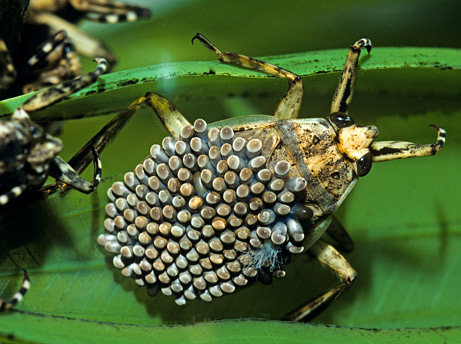In the animal Kingdom, parental care often falls to the female. However, some species rely on males to be the main caregiver for their young. In this Fun Facts post we will be taking a look at some Dads that go above and beyond in raising their offspring.
Giant Water Bug (Belostomatidae family)
The male Giant Water Bug plays an important role in rearing his young. The female Giant Water Bug attaches fertilized eggs onto her mate’s back and then leaves the area. The water bug dad takes on the responsibility of carrying and caring for the eggs. To ensure that the developing embryos receive enough oxygen, he will periodically surface, allowing the embryos to breathe more efficiently because it is much easier to absorb oxygen from the air. When the male is underwater he will do “pushups” to help water flow around the eggs so that they can absorb more oxygen from the water. Right before his offspring hatch, this devoted dad will stop eating so that he avoids consuming his offspring.
Photo by Gerald and Buff Corsi
Darwin Frog (Rhinoderma darwinii)
A Darwin Frog father carries his babies inside a pouch of sagging skin under its chin. The tadpoles stay there until they are big enough to swim off on their own. Some male frogs in Papua New Guinea transport their babies on their backs. As they mature, their offspring jump off at different points, to find their own place in the big world.
Illustration by ilknowledge.com
Photo by ilknowledge.com
Sea Catfish (Ariidae family)
The male Sea Catfish incubates eggs in his mouth, in a process known as mouthbrooding. This means that he cannot eat until the eggs hatch! It takes one month for the eggs to hatch and a further 2-3 weeks for the young to become independent, and during this time the male lives off of stored body fat!
Photo by abadonian/iStock/GettyImages
Seahorses (Hippocampus genus)
Seahorses are one of the only animals known for male pregnancy! A female seahorse will deposit her eggs into the male’s brood pouch where he fertilizes and incubates them. A male seahorse will go through 3 weeks of pregnancy and hours of labour to give birth to over 200 tiny seahorses.
Photo by Rudie Kuiter
Foxes (Vulpes genus)
Typically, mammalian females are very involved with raising their young, but this doesn’t mean that the males don’t play an important role as well! For example, male foxes spend as much, if not more, time guarding, grooming and rearing the young as the females do. After giving birth, a female red fox will remain in the den to feed her kits and keep them warm. The male is responsible for finding food for the whole family but this doesn’t last forever. Once the pups have matured a bit, the father stops feeding the pups and begins to teach them how to hunt and scavenge. He will bury surplus food close to the den and disguise it with leaves and twigs, which teaches the pups to sniff and forage. Some foxes have been observed playfully ambushing their offspring as a way to teach them how to escape from predators. A father who makes learning fun – who could ask for more!
Photo by jayhawk6







